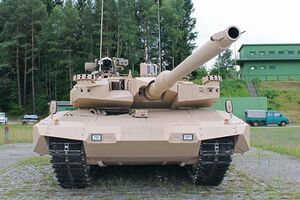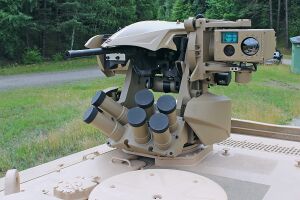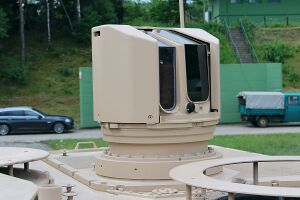Panzerkampfwagen XI Ausf.E
This article is incomplete because it is pending further input from participants, or it is a work-in-progress by one author. Please comment on this article's talk page to share your input, comments and questions. Note: To contribute to this article, you may need to seek help from the author(s) of this page. |
| PzKpfw XI Ausf.E | |
|---|---|
 | |
| Type | Main Battle Tank |
| Place of origin | |
| Service history | |
| Used by | |
| Production history | |
| Designer | Kessel-Hassen |
| Designed | 2008-2014 |
| Manufacturer | Kessel-Hassen |
| Produced | 2017-Present |
| Specifications | |
| Weight | 64.1 tonnes (70.7 short tons; 63.1 long tons) |
| Length | 10.8 metres (35 ft 5 in) gun forward 7.72 metres (25 ft 4 in) hull length |
| Width | 4.0 metres (13 ft 1 in) |
| Height | 3.0 metres (9 ft 10 in) |
| Crew | 3 (commander, gunner, driver) |
| Armor | Composite |
Main armament | 1x Karlsbranchen 128mm L/52 cannon (40 rounds) |
Secondary armament | 1x RAG MG 16 1x Blitz & Keckler MG 60 |
| Engine | 27.4L V12 liquid cooled turbo-diesel 1620 PS @ 2600 rpm |
| Power/weight | 25.3 PS/t |
| Transmission | Automatic (5 forward gears, 5 reverse) |
| Suspension | Torsion bar |
| Ground clearance | 500 millimetres (1 ft 8 in) |
| Fuel capacity | 1,200 L (320 US gal) |
Operational range | 620 km (390 mi) |
| Speed | 72 km/h (45 mph) |
The PanzerKampfwagen XI Ausf.E is the most modern variant of the Panzerkampfwagen XI designed and produced by Kessel-Hassen for the Bodentruppen. It was developed using technologies pioneered by the cancelled MBT 2000 project.
Development
In the 1990s, the Bodentruppen were concerned that the current generation of PzKpfw XI tanks would be incapable of combating future armored threats produced by Trinovantum. The Trinovantan TAG-33 then in service had proven to be resistant to a wide variety of weapons, including cannons similarly powerful to the PzKpfw XI. Further, it was known to the Bodentruppen that the Trinovantan military was developing a replacement to the TAG-33 and it was believed that this vehicle would have an even greater level of protection and combat capabilities than the TAG-33. Working under these assumptions, the Bodentruppen issued the MBT 2000 program in 1994 to create a new vehicle that could defeat these current and future threats.
The MBT 2000 program's operational requirements were extreme: The vehicle was to possess a gun that was capable of at least a 40% increase in muzzle energy over the PzKpfw XI's current gun. This weapon had to not only fire conventional projectiles, but also advanced guided shells capable of engaging targets outside of the vehicle's line of sight. A prospective MBT 2000 vehicle also had to possess both soft and hardkill active protection systems, in addition to enough passive protection measures to resist its own cannon from the frontal aspect at a range of at least 1000 meters. Further, it had to weigh no more than 70 metric tonnes and be no less mobile, overall, than the PzKpfw XI it would replace. There was no initial limit in terms of projected vehicle costs nor program costs.
Several companies were contracted to build specific components of the vehicle. It was expected that these companies, working in parallel with each other and free from the normal pressure of competition, would be able to complete their work quickly. However, delays in key components caused the program to exceed its first deadline of a complete vehicle by the year 2000. The cost of the program was also rising at an alarming rate. Spending limits were instituted in order to curtail some of the development costs, and a new deadline of a feature-complete prototype was set for the year 2008. However, in 2004 a more complete analysis of the Trinovantan TAG-38 showed it did not have radically improved combat capabilities over the TAG-33 as was believed. A combination of this and the exorbitant costs of the MBT 2000 program caused a change in opinion regarding the necessity of the program. Eventually, the program was cancelled in 2006. By this point, several of the advanced components of the vehicle were complete, and Kessel-Hassen had already produced a full-scale hull and several smaller scale complete models of their MBT 2000 proposal.
While there was no longer any interest in the MBT 2000 vehicle, several of the components that were to be installed on the MBT 2000 were mostly or even fully developed. Further more, many of these components used older PzKpfw XI models for practical testing. In 2008, Kessel-Hassen proposed a comprehensive upgrade of the PzKpfw XI vehicle with these technologies to the Bodentruppen. This garnered interest from the Bodentruppen's procurement office, and was promptly accepted, with key components of the MBT 2000 program allowed to resume development for this new application. By 2011, most technologies had been successfully applied to a single PzKpfw Ausf.D test vehicle equipped with a new set of ceramic-composite applique armor developed by Kessel-Hassen. The final MBT 2000 technology, the hard-kill active protection system, was integrated to the test vehicle in 2012. Over the next two years, this demonstrator vehicle would be extensively tested and tweaked. The final vehicle was presented to the Bodentruppen in 2015 and, after a second round of testing and a low-rate initial production run, accepted into service in 2018.
Design
Armament
The primary armament of the PzKpfw XI Ausf.E is the Karlsbranchen 128mm L/52 autoloaded cannon. While this cannon is derived from the older 128mm L/40 cannon used on the PzKpfw XI, it shares little in common with its predecessor. It features a significantly reinforced breech and chamber, in addition to a longer barrel. Further, it is equipped with a new compact bustle autoloader designed specifically to fit within the PzKpfw XI's turret space. This autoloader holds 20 rounds ready to fire, with an additional 20 rounds stored in a reinforced hull magazine. With the new autoloader, the cannon is capable of firing at a consistent 12 rounds per minute. It is capable of firing ammunition from the previous 128mm L/40 cannon, as well as a selection of new ammunition designed during the MBT 2000 program. The most notable among the new ammunition developed for the weapon is a tungsten APFSDS round with a larger, improved penetrator design and increased propellant load that produces nearly 18 MJ of muzzle energy, compared to the previous 12 MJ generated by the APFSDS rounds that were safe to fire in the older 128mm L/40 cannon. This new APFSDS ammunition is capable of defeating the improved armor profile of the PzKpfw XI Ausf.E at any range. Other ammunition includes a new multi-purpose tandem HEAT round which provides improved performance against structures and reactive armor and a selection of two self-guiding non-line-of-sight guided shells, one equipped with a shaped charge warhead and the other being a hit to kill missile with a steel penetrator and a terminal-phase rocket assist. However, these guided shells are not being produced in significant numbers due to the expense of these systems.
For engaging lighter targets, the PzKpfw XI Ausf.E retains the coaxial Biltz & Keckler MG 60 from older models of the PzKpfw XI. However, the pintle-mounted MG 60 mounted on the turret has been replaced with a remote weapon station mounting the Reich Ausrüstung Gesellschaft MG 16 13.2mm heavy machine gun, both systems designed for the MBT 2000 program. This electrically driven heavy machine gun provides greater firepower, accuracy, longer range and greater reliability compared to the MG 60, and can be completely operated from within the vehicle.
Protection
The PzKpfw XI Ausf.E retains the underlying armor scheme of the PzKpfw Ausf.D, using an array of hardened steel, titanium and tungsten plates separated by elastic inserts. While this provided a formidable degree of protection in the 1980s, increasingly advanced anti-armor weapon systems have rendered the protection offered by these older vehicles insufficient. As such, the PzKpfw XI Ausf.E is equipped with a comprehensive applique armor package developed by Kessel-Hassen. This armor package consists of ceramic-composite add-on armor along the turret face and sides, as well as the front hull. The rear of the turret and the sides and rear of the hull are given additional protection by a steel slats covered by a ballistic fabric. Altogether, this applique armor package is mostly responsible for the increase in weight from the 56 tonne Ausf.D to the current vehicle's weight of 64 tonnes. It provides a significant increase in protection, making the PzKpfw XI Ausf.E able to resist the 128mm L/40 cannon used on the Ausf.D model from the frontal arc. The side of the turret can resist up to 50mm armor-piercing projectiles, as well as most infantry-portable anti-tank missile and rocket systems. The sides of the hull and the vehicle's rear retains protection from up to 15mm armor piercing projectiles, with the new slat armor providing stand-off protection from older shaped charge anti-tank weapons systems.
Additional protection is provided by the combined softkill and hardkill active protection systems equipped on the vehicle. These systems have 360 degree coverage and a rapid reaction time. Data for the active protection system is provided by optical sensor arrays installed at each of the four corners of the turret. These arrays also include a compact electro-optical jammer for disrupting command guidance ATGMs. A laser warning system is installed on the vehicle, and linked to the four rapid-deployment smoke discharges mounted on the top corners of each turret. This system can project IR and laser obscuring smoke at any angle of the vehicle within 0.6 seconds of detecting an incoming threat. If a projectile manages to circumvent these softkill defenses, the hardkill system can intercept it. Using data from the vehicle's 360 degree sensor array, the hardkill APS can detect and identify a target within 500 microseconds, and intercepts incoming projectiles using a steerable shaped charge at a range of less than 10 meters from the vehicle. Due to the rapid identification capabilities of this system it can intercept even kinetic energy penetrators, which significantly degrades their performance against the vehicle's passive protection systems. The hardkill modules can be mounted on any side of the turret, and the steerable charges contained within are capable of engaging threats in a wide angle from the individual modules, which provides some multi-hit capabilities.
The PzKpfw XI Ausf.E retains the compartmentalized hull structure of the older PzKpfw XI models. The hull fuel tanks are isolated from the fighting compartments. The hull ammunition magazine is separated from the fighting compartment by a fireproof bulkhead, and has been reinforced compared to older models. It also retains the automatic halon fire extinguisher and the NBC overpressure systems from older models.
Mobility
The PzKpfw XI Ausf.E is equipped with a lightly modified variant of the compact powerpack designed for the MBT 2000. It is powered by a 27.4 liter liquid cooled V12 turbo-diesel, which produces 1620 PS at 2700 rpm and 4550 NM at 2000 rpm. Much like the previous engine used in the PzKpfw XI, it is multi-fuel capable. While it produces slightly more power than the older engine, it is also lighter and more fuel efficient, which gives the Ausf.E a noticeably improved range over its predecessors. This engine is mated to a ten speed (five forward, five reverse) automatic transmission. The vehicle has a governed maximum speed of 72 km/h, and is capable of speeds in excess of 50 km/h in cross country maneuvering. The forward and reverse gears have the same gear ratios, which allows the vehicle to maneuver as quickly in reverse as it can in forward motion. With a full fuel load, the vehicle has a road-going range of 620 kilometers and a cross country range of approximately 350 kilometers. As per previous PzKpfw XI models, the power pack can be removed and replaced in 40 minutes with simple tools.
The Ausf.E makes no modifications to the PzKpfw XI's torsion bar suspension system with seven road wheels and four return rollers per side. The suspension has an object clearance of 1 meter and a trench clearance of 3 meters. It can traverse a gradient of up to 60 degrees or a side-slope of up to 30 degrees without slipping. It can ford up to 1.2 meters of water without preparation, or 4 meters with preparation.
Sensors and Systems
The PzKpfw XI Ausf.E is equipped with a modern, fully digital fire control system. A vast array of sensors are present that automatically feed data into FCS's ballistic computer, including a laser rangefinder, a static cant sensor, a new crosswind sensor, a muzzle reference system, temperature and pressure senors, a tracking rate sensor, and selected ammunition type. With this extensive sensor array, the ballistic computer can create accurate firing solutions with minimal input from the vehicle crew. In practical terms, the vehicle can achieve extremely high (90+%) hit rates even while both the vehicle and the target are moving. The commander's station can take control of the gun at any time, and can both use the gunner's sensor and fire control systems.
The gunner's station has access to both a wide angle search optic and a variable zoom (2-14x) targeting optic, both of which are equipped with a generation 3+ image intensifier and a thermal imaging channel. The gunner also retains access to the auxiliary 8x optical telescope from older PzKpfw XI models for use in the event that the vehicle's digital optics fail. The commander's station has access to an independent sight mounted on the turret that has a 1-10x variable zoom as well as image intensification and thermal imaging channels and a full 360 traverse. As per the older PzKpfw XI models, the commander also has access to a panoramic search periscope that can be rotated 360 degrees. This telescope is fitted with an image intensifier. Both the gunner's and commander's station can also be configured to receive alerts from the vehicle's 360 degree surveillance system and laser warning receiver, which can greatly enhance the crew's situational awareness. The driver has a single forward-facing wide angle optic with imagine intensification for low-light maneuvering.
Unlike previous models, the PzKpfw XI Ausf.E is equipped with an electric powered turret traverse system. This system is both safer and more reliable than the hydraulic system present older models. The Ausf.E's turret can traverse it's full 360 degree rotation arc in approximately 7 seconds, with an elevation arc of 20/-9 degrees. The vehicle is fitted with a small auxiliary power unit that can provide power to the vehicle's vast array of electronics even while the engine is shut down. This APU is fitted as part of the vehicle's powerpack, and thus can be easily removed and replaced for maintenance.




